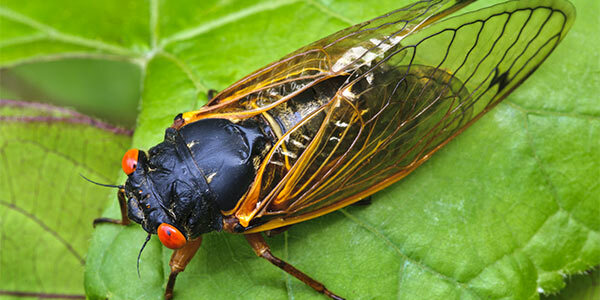Dogs and Cicadas: What you need to know
Friday May 17, 2024

The cicadas are coming…and it’s creating quite a buzz!
Things are warming up, and for this year, trillions of cicadas are expected to emerge from the ground beginning in May. Notable for 2024 is the co-emergence of a 13-year and a 17-year brood of cicadas simultaneously. The last time these specific brood groups emerged in the same season was in 1803. The next time two cicada broods co-emerge will be in 2037. We are witnessing extraordinary natural cycles. And it will be loud.
As the ground temperature reaches 64 degrees, nymphs hatched 13 and 17 years ago, return to the surface still in their juvenile form, to mature into adults, mate, and lay the next generation’s eggs. And to sing, of course. Once above ground, the nymph begins a two-hour molting process, which includes shedding its juvenile hard ‘skin’, or exoskeleton. Without this hard casing, the cicadas adult body and new wings are freed, and the cicada begins a 6-week maturation cycle, mating, and laying eggs in plants and trees. Once cicada nymphs hatch from the egg, they fall to the ground and burrow underground, where they will live for the next 13, or 17, years. The adults remain above ground and eventually die. The whole cycle takes about 6 weeks….and results in many insect skeletons on the ground…which are thoroughly enjoyed by fish, mammals, and birds. And dogs, of course. Which begs the question – “Are cicadas toxic to dogs?”

Photo Credit: National Wildlife Federation
The good news is that cicadas are not poisonous to dogs.
When it comes to ingesting cicadas, the risk for dogs is more like an irritant versus a toxin. The hard exoskeleton can cause varying degrees of gastrointestinal irritation depending on how many crunchy morsels are consumed. One or two may not be an issue, but more significant amounts can be a real problem. Because the exoskeleton is so difficult to digest, dogs who have eaten several cicadas can experience abdominal pain, lethargy, vomiting, and bloody diarrhea. In severe cases, dogs may need to be hospitalized on IV fluids.
Two additional (and less common) issues for dogs who eat cicadas are that the hard exoskeleton and wings can be a choking hazard, AND some dogs might even be allergic to cicadas. Not only can dogs have a local irritating reaction to the tiny hair-like structures called setae, on the legs of cicadas, but sometimes they can cause an actual immune response, causing intense itch, just like a contact allergy. And a final not-so-fun fact - because cicadas and shellfish are biologically similar, people and animals with shellfish allergies can have similar allergic reactions when eating cicadas. Some entomologists (insect scientists) develop a seafood allergy which is thought to be due to exoskeletons of the insects they study. Even the FDA recommends not eating cicadas if you are allergic to seafood.
Obviously, preventing your dog from eating cicadas is the best way to avoid gastrointestinal issues. If you live in an area experiencing the cicada bloom, and your dog is lethargic, inappetent, experiencing vomiting, or has bloody diarrhea, seek immediate help from a veterinarian.
Here are some ways to minimize cicada ingestion in your dog:
- Teaching the ‘Leave it’ and ‘Drop it’ commands.
- Accompany your puppy or dog when they go outside so you can closely supervise and prevent cicada ingestion.
- Leash walking away from shrubs, trees and fences during the emergence might be necessary.
- Take treats on your walk to redirect your dog away from cicadas they encounter.
- Regularly rake up the exoskeletons in your yard to reduce the risk of ingestion for your dog.

